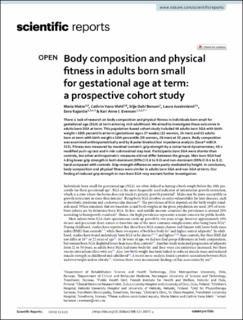| dc.contributor.author | Matre, Maria | |
| dc.contributor.author | Mehl, Cathrin Vano | |
| dc.contributor.author | Benum, Silje Dahl | |
| dc.contributor.author | Jussinniemi, Laura | |
| dc.contributor.author | Kajantie, Eero Olavi | |
| dc.contributor.author | Evensen, Kari Anne Indredavik | |
| dc.date.accessioned | 2023-09-08T12:02:03Z | |
| dc.date.available | 2023-09-08T12:02:03Z | |
| dc.date.created | 2023-03-15T18:13:19Z | |
| dc.date.issued | 2023 | |
| dc.identifier.citation | Scientific Reports. 2023, 13 (1), . | en_US |
| dc.identifier.issn | 2045-2322 | |
| dc.identifier.uri | https://hdl.handle.net/11250/3088310 | |
| dc.description.abstract | There is lack of research on body composition and physical fitness in individuals born small for
gestational age (SGA) at term entering mid-adulthood. We aimed to investigate these outcomes in
adults born SGA at term. This population-based cohort study included 46 adults born SGA with birth
weight < 10th percentile at term (gestational age ≥ 37 weeks) (22 women, 24 men) and 61 adults
born at term with birth weight ≥ 10th percentile (35 women, 26 men) at 32 years. Body composition
was examined anthropometrically and by 8-polar bioelectrical impedance analysis (Seca® mBCA
515). Fitness was measured by maximal isometric grip strength by a Jamar hand dynamometer, 40-s
modified push-up test and 4-min submaximal step test. Participants born SGA were shorter than
controls, but other anthropometric measures did not differ between the groups. Men born SGA had
4.8 kg lower grip strength in both dominant (95% CI 0.6 to 9.0) and non-dominant (95% CI 0.4 to 9.2)
hand compared with controls. Grip strength differences were partly mediated by height. In conclusion,
body composition and physical fitness were similar in adults born SGA and non-SGA at term. Our
finding of reduced grip strength in men born SGA may warrant further investigation. | en_US |
| dc.language.iso | eng | en_US |
| dc.rights | Navngivelse 4.0 Internasjonal | * |
| dc.rights.uri | http://creativecommons.org/licenses/by/4.0/deed.no | * |
| dc.title | Body composition and physical fitness in adults born small for gestational age at term: a prospective cohort study | en_US |
| dc.type | Peer reviewed | en_US |
| dc.type | Journal article | en_US |
| dc.description.version | publishedVersion | en_US |
| cristin.ispublished | true | |
| cristin.fulltext | original | |
| cristin.qualitycode | 1 | |
| dc.identifier.doi | 10.1038/s41598-023-30371-y | |
| dc.identifier.cristin | 2134260 | |
| dc.source.journal | Scientific Reports | en_US |
| dc.source.volume | 13 | en_US |
| dc.source.issue | 1 | en_US |
| dc.source.pagenumber | 0 | en_US |

